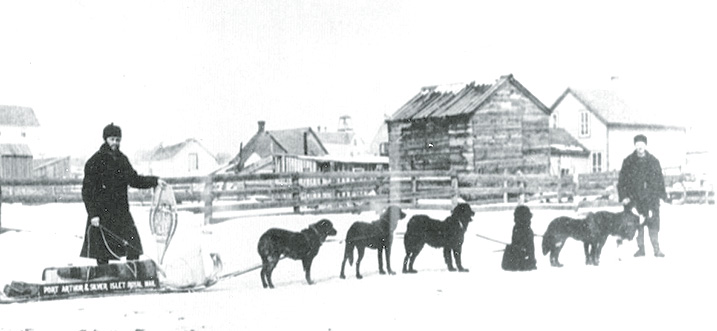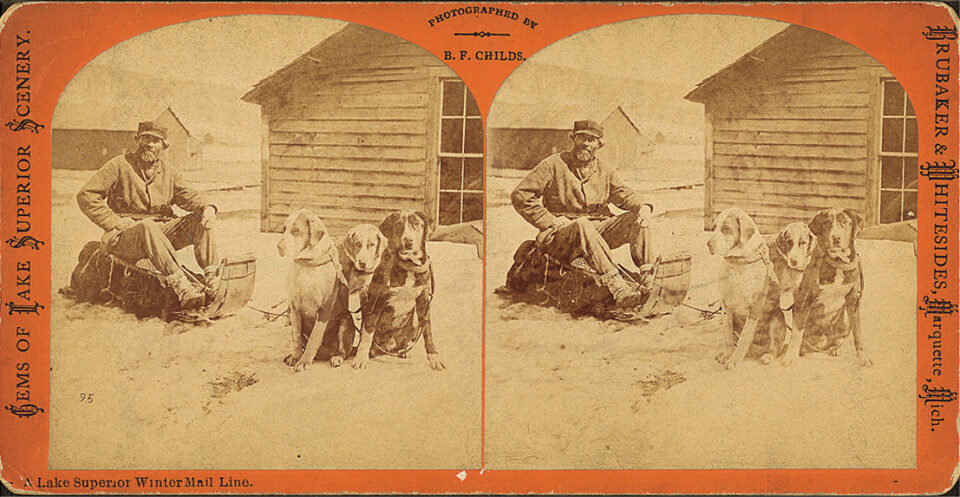Early residents in the sparsely populated settlements along the North Shore of Lake Superior only had one way to communicate with the outside world: by mail. Mail was sent and delivered by an eclectic mix of transporters, including via fur trade, ship’s captains, and travellers.
In present-day Canada, the first official government postal service began on July 1, 1776, between Halifax and Fort William (now Thunder Bay). A few weeks later on July 26, 1775, the first U.S. postal system was established, with Benjamin Franklin appointed as its first Postmaster General.
Fast forward to 1845, when U.S. legislation put the postal system into service and began awarding contracts to bidders for mail delivery. However, it wasn’t until 10 years later that the U.S. Congress ordered the “beginning of a mail service from Superior, Wisconsin, to Grand Marais, Minnesota.”
Locals bid to get the contracts for those mail delivery routes on the North Shore and had to provide their own transportation for those deliveries. At the time, horseback riding or using horse-drawn wagons weren’t an option as there were no roads. So in spring, summer, and fall, they used rowboats, canoes, walking or hiking, and steamer ship. In winter, primarily dogsleds and snowshoes were used.
The Minnesota Historical Society wrote, “The mail carrier was the link to the outside world for people living along the North Shore. Everyone waited his arrival with anticipation. He was the weather broadcaster and news teller. News of national importance or letters from loved ones were in his pack.”
Travelling the North Shore mail routes was no easy task. Winter mail carriers travelled by dogsleds or snowshoes over rough trails, frozen rivers, ice-covered Lake Superior, and through blizzards, and freezing cold temperatures. In summer, using rowboats, canoes, and hiking exposed them to sudden storms, large waves, winds, and hot weather.
Here’s a snapshot look at a few of the early mail carriers.
The first mail carrier on the Superior to Grand Portage route was Robert H. McLean in 1856. After he put the mail in waterproof canvas or hides, the load was placed in the bottom of his 18-foot cedar Mackinaw rowboat, equipped with oars and sails. After service to Grand Portage, McLean sailed from the mainland across Lake Superior to Isle Royale for delivery to the fishing and mining communities before returning to Grand Portage and along the shoreline back to Superior.

After McLean resigned a few years later (but stayed in area), German-born immigrant Albert Weiland from Beaver Bay was the successful bidder on the 166-mile route “From Superior by Duluth, Beaver Bay, Grand Marais, Sexton and Grand Portage and Pigeon River” twice a month. He held the contract for almost three decades. Often, he made the trip himself, but other times he subcontracted the weekly route to McLean and others from Beaver Bay, such as John Morrison and Chief Beargrease.
Another early mail carrier was Joseph Godfrey Montferrand who worked the 35-mile weekly route from Grand Marais to Grand Portage. Sometimes he brought along his nephew Louis Plante, who later became one of the area’s famous mail mushers.
Then there’s mail carrier Antonine Dennis who walked his weekly Superior to Bayfield mail route, rain and shine, by moccasin or snowshoes for $52 a month. He carried about 70 pounds of mail, plus supplies of pork, tea, bread, and a hand axe. As the story goes, in winter, he used snowshoes to dig a hole in the snow and cut balsam branches to layer them to make a cozy place to sleep.
The North Shore’s most famous mail carrier is the legendary John Beargrease from Beaver Bay. Beginning in 1879 and for the next 20 years, Beargrease and his brothers carried mail once or twice a week year-round from Two Harbors to Grand Marais, and sometimes to Grand Portage. Their load was up to 700 pounds of personal mail, packages, newspapers, and weather reports. In summer, they trekked along rugged shoreline trails, sailed, or used rowboats. In winter, they could cover 30-40 miles a day with their four-dog teams. Honoring him is the annual “John Beargrease Sled Dog Marathon,” a premier long-distance sled dog race starting in Duluth and ending in Grand Portage. (Next year, the 40th run of the race will start on January 28.)
While schooners and steamships during navigation season brought mail to residents on Lake Superior’s North Shore, during winter, the Canadian mail was routed through Detroit, Chicago, St. Paul, Duluth, and Pigeon River. From there, Canadian mail carriers brought the mail to the Lakehead (Port Arthur and Fort William) and surrounding settlements like Silver Islet.
An Ontario Historical Plaque installed on the roadside of Highway 61 into Thunder Bay gives a glimpse of how the mail came up from Pigeon River to today’s Thunder Bay. It reads:
Pigeon River Road
“This road was constructed to facilitate the transportation of mail between Thunder Bay and Duluth during the winter months when navigation was closed on Lake Superior. Demands for a reliable year-round mail service arose with the development of the Silver Islet Mine in 1870. A temporary mail trail was opened in 1872 before a 38-mile winter road was constructed from Fort William to the Pigeon River by John Carroll in 1873-74. The poorly built road was used by mail couriers until the completion of the C.P.R. [Canadian Pacific Railway] to Thunder Bay in 1882. As the area traversed by the road remained sparsely settled, it was little used and much of it was abandoned when the International 1 or “Scott,” Highway (Later No. 61) was constructed in 1913-17.”





